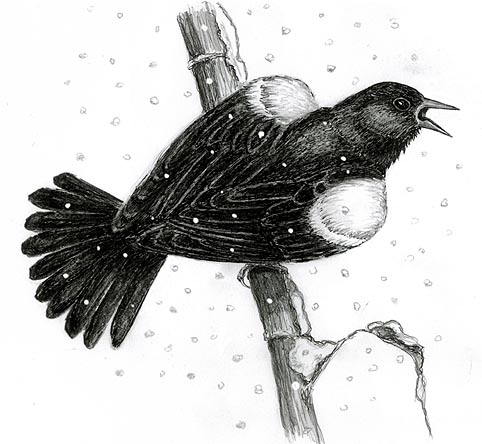
Dear Bird Folks,
All of my life I have been happily believing that the robin is the first bird of spring. It gave me great comfort knowing that when the robins arrived, spring was on the way. Well, all that comfort ended when I read one of your recent columns. You coldly stated that robins are with us year round and thus cannot be used as indicators of nicer weather. Fine, I can accept that. But if the robin is no longer the first bird, which bird is? And when will it finally get here? I’ve had enough of this nasty winter.
-Artie, Allentown, PA
Sorry Artie,
I’m sorry for spoiling your warm and fuzzy story about the robins. Even though it may be true that robins aren’t the first sign of spring, that’s no reason to think any less of them. Heck, without the robin we would be in danger of being overrun by worms. Earthworms have developed a very sophisticated and dangerous underground movement. It’s the robins that stand between us and total worldwide worm domination. Sounds like a story for FOX News. They’ll believe anything.
The first bird of spring really depends upon where you live. For parts of northern New England and most of Canada, the American Robin may very well be the first migrant of spring. It is absent from those areas during the winter. In my neighborhood we see robins every day of the year, so their appearance doesn’t mean better weather is coming. The bird that means spring to me is a Thunderbird, a candy apple red Thunderbird convertible, driven by Lloyd Townsend, a guy who lives around the corner. Ol’ Lloyd treats this car better than most people treat their lungs. It stays wrapped up in his heated garage, hibernating until winter passes. When I see that red T-bird cruising down the road, I know that spring is here for sure.
You are right to look for birds as a sign of spring, for birds are amazingly reliable indicators. Insects and plants can be fooled by a warm spell. We’ve all seen flies buzzing around on an unusually warm day in January. A warm winter’s day will also convince crocus bulbs to start sprouting early, only to be buried for another eight weeks under snow and ice. Birds aren’t fooled by the occasional warm spell.
Why aren’t birds fooled? How are they able to accurately know when it’s time to migrate? Since very few birds can afford watches and even fewer can figure out how to adjust them for daylight savings time, they have another way of determining time. Birds have photoreceptors at the base of their brains that record the length of day. Oddly, the birds don’t measure the amount of daylight, but they apparently focus in on the amount of darkness (talk about being negative). They then are somehow able to do the math and conclude that shorter nights equal longer days and longer days mean spring is on the way.
My favorite returning bird of spring, besides Lloyd’s T-bird, is the woodcock. Woodcocks are prehistoric-looking, long-beaked, woodland “shorebirds,” that look like water balloons with handles. They appear to be far too fragile and goofy to be able to survive a night of fog, let alone a late winter snow storm. But by the end of every February, including this one, the reports come streaming in from people who have been hearing returning woodcocks performing their mating display.
A far more common signal that spring is returning is the reappearance of Red-winged Blackbirds. Amazingly, as early as late February or early March, redwings are back, ready to begin the breeding season once again. Some locations have redwings year round, but only when winter is winding down do we hear the singing males as they settle back into the marshes and giving their signature “konk-le-reee” song.
And let’s not forget our backyard goldfinches. Even though goldfinches visit many of our yards every day of the year, a sure sign of spring is when, in early March, the males start shedding their winter coats and we see flecks of gold showing through their dull green winter plumage. You know Artie, you can still use your beloved robins as a sign of spring, but not those robins that you see in large flocks eating fruit from bushes. It’s the robins we see running across our lawns, protecting us from the next earthworm attack, that tell us that winter is on the way out.
By carefully studying the ways of nature, you will begin to appreciate the subtle clues that will tip you off as to which seasons are coming and which seasons are going. Either that or go out and buy yourself a calendar, which isn’t a bad idea since they are on sale right now.